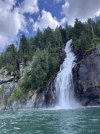Hamster
Well-known member
- Joined
- Oct 8, 2018
- Messages
- 261
- Fluid Motion Model
- C-242 C
- Hull Identification Number
- FMLT2314F819
- Vessel Name
- Tokitae
 We just got back from two weeks cruising the Gulf Islands, Desolation Sound, Toba Inlet and Octopus Islands in our “weekend” boat, the R-23. Two adults and yellow lab. I’ve done a lot of extended backcountry climbs and whitewater rafting and always felt prepared for most things. But after this trip, I learned to add a couple of things to my checklist.
We just got back from two weeks cruising the Gulf Islands, Desolation Sound, Toba Inlet and Octopus Islands in our “weekend” boat, the R-23. Two adults and yellow lab. I’ve done a lot of extended backcountry climbs and whitewater rafting and always felt prepared for most things. But after this trip, I learned to add a couple of things to my checklist.Inflatable boats. To get to shore for the dog or stern tie, I take an inflatable kayak that is ready to launch. I also carry a Takacat that I need to assemble. On one trip to shore, my kayak found an oyster shell and ripped a 7” gash in the boat. I was able to get back with one tube and the floor still inflated but I didn’t have a proper repair kit on board. I tried waterproof duct tape but it didn’t work. If I ripped a hole in the Takacat, I would be in an uneasy place. Lesson learned: take a proper repair kit if you have inflatable boats.
Stern ties. This was the first time we did stern ties. 5 nights. I had spooled my yellow poly onto a garden hose reel several years ago. When unspooling the first night, part of the rope came off the spool and wrapped around the drum, creating knots. I had to come back to the boat and destroy the hose reel with a hammer to clear the line. The second night the winds picked up and when waking up in the morning, we found that our anchor drug. I had to untie the stern, raise the anchor and reset all. Lessons leaned: check your spool before your trip and don’t put more rope than your spool can handle. Don’t assume less anchor scope due to a stern tie.
Dog first aide. Our yellow lab loves the water and has little fear running across the beach at low tide. Oyster shells and barnacles aren’t very nice to her paws. She ended up with cuts to both of her rear paws, which continues to challenge us two days after we returned. Last year in Tofino, her eye swelled, maybe due to jellyfish or something else. Lessons learned: we’ve since heard that there are barnacles booties for dogs and we need to bring other meds to address ears, eyes, and rashes.
Groceries. Since we went before June, we had not realized that some of our grocery places weren’t open yet or well stocked (Refuge Cove). Check the hours before you leave and plan accordingly. In order to have dinner, I “had to” catch a salmon.
Those are the new things for my checklist. There are many others already on it, like using a Garmin InReach to message location when cell isn’t available, carrying spare parts like anchor, water pump, oil, lights, fuses, tools, etc.
Last edited:
